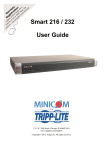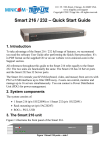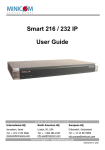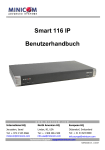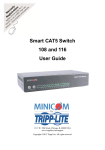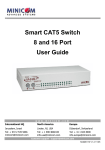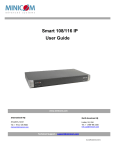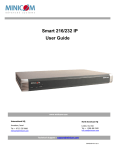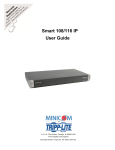Download Minicom Advanced Systems SMART 216 User guide
Transcript
Smart 216 / 232 User Guide w w w . m i n i c o m . c o m International HQ North American HQ European HQ Jerusalem, Israel Linden, NJ, USA Dübendorf, Switzerland Tel: + 972 2 535 9666 [email protected] Tel: + 1 908 486 2100 [email protected] Tel: + 41 44 823 8000 [email protected] Technical support - [email protected] 5UM20185 V1 8/08 SMART 216 / 232 Table of Contents 1. Welcome ...................................................................................................................... 3 2. Introduction ................................................................................................................. 4 3. Key features ................................................................................................................ 4 4. System components.................................................................................................... 4 5. Compatibility ............................................................................................................... 4 6. The Smart 216 unit ...................................................................................................... 5 6.1 LED and button table .......................................................................................................................... 5 6.2 Connector table ................................................................................................................................... 5 7. Pre-installation guidelines........................................................................................... 6 7.1 Avoiding general rack mounting problems ......................................................................................... 6 7.2 Rack mounting the Smart 216 ............................................................................................................ 7 8. Connecting the system ............................................................................................... 8 8.1 The ROCs............................................................................................................................................ 8 8.1.1 Connecting a ROC PS/2 ............................................................................................................ 9 8.1.2 Connecting a ROC USB ........................................................................................................... 10 8.2 Connecting the CAT5 cables ............................................................................................................ 10 8.3 Connecting the two KVM consoles................................................................................................... 11 8.4 Connecting to the power supply ....................................................................................................... 11 9. Configuring the system............................................................................................. 11 9.1 Connecting to the Local Area Network (LAN) .................................................................................. 11 9.2 Setting network parameters via the OSD......................................................................................... 11 9.2.1 Changing the Network parameters .......................................................................................... 12 10. Logging into the web configuration ........................................................................ 13 10.1 Changing the password .................................................................................................................. 14 11. Configuring the system ........................................................................................... 14 11.1 Network > Configuration ................................................................................................................. 14 11.1.1 LAN ......................................................................................................................................... 14 11.2 Administration > User Settings ....................................................................................................... 15 11.2.1 Adding a user.......................................................................................................................... 16 11.2.2 Deleting a user........................................................................................................................ 16 11.2.3 Blocking a user ....................................................................................................................... 16 11.3 Administration > Switch Configuration ........................................................................................... 17 11.4 Administration > Power Management ............................................................................................ 18 12. Administration > User Targets ................................................................................ 19 13. Security > Settings .................................................................................................. 20 14. Security > SSL Certificate ....................................................................................... 21 15. Maintenance > Switch Upgrade............................................................................... 21 16. Maintenance > RICCs/RoCs Upgrade...................................................................... 22 17. Restore Factory Settings......................................................................................... 22 18. Set Time & Date ....................................................................................................... 23 19. Backup & Restore.................................................................................................... 24 20. Saving changes and logging out............................................................................. 24 21. Event log.................................................................................................................. 25 1 USER GUIDE 21.1.1 Downloading the log ............................................................................................................... 25 21.1.2 Clearing the log....................................................................................................................... 25 22. Operating the system via the OSD .......................................................................... 26 22.1 Navigating the OSD Main window.................................................................................................. 26 22.2 Selecting a computer ...................................................................................................................... 26 22.3 Power management hotkey – left Shift, F12 .................................................................................. 27 22.4 Moving the Confirmation label – F1................................................................................................ 27 22.5 Tuning – F5 ..................................................................................................................................... 28 22.6 The Settings window - F2 ............................................................................................................... 28 22.7 DDC – F10 ...................................................................................................................................... 29 22.8 Saving changes to the settings....................................................................................................... 29 23. Technical specifications.......................................................................................... 30 24. Safety....................................................................................................................... 31 25. User guide feedback................................................................................................ 31 26. WEEE compliance ................................................................................................... 31 © 2008 Copyright Minicom Advanced Systems. All rights reserved. 2 SMART 216 / 232 1. Welcome Thank you for buying the Smart 216 / 232 system. This system is produced by Minicom Advanced Systems Limited. This document provides installation and operation instructions for Minicom’s Smart 216 / 232. It is intended for system administrators and network managers, and assumes that readers have a general understanding of networks, hardware and software. Technical precautions This equipment generates radio frequency energy and if not installed in accordance with the manufacturer’s instructions, may cause radio frequency interference. This equipment complies with Part 15, Subpart J of the FCC rules for a Class A computing device. This equipment also complies with the Class A limits for radio noise emission from digital apparatus set out in the Radio Interference Regulation of the Canadian Department of Communications. These above rules are designed to provide reasonable protection against such interference when operating the equipment in a commercial environment. If operation of this equipment in a residential area causes radio frequency interference, the user, and not Minicom Advanced Systems Limited, will be responsible. Changes or modifications made to this equipment not expressly approved by Minicom Advanced Systems Limited could void the user’s authority to operate the equipment. Minicom Advanced Systems Limited assumes no responsibility for any errors that appear in this document. Information in this document is subject to change without notice. No part of this document may be reproduced or transmitted in any form or by any means, electronic or mechanical, for any purpose, without the express written permission of Minicom Advanced Systems Limited. Trademarks All trademarks and registered trademarks are the property of their respective owners. 3 USER GUIDE 2. Introduction All references throughout this guide to the Smart 216 refer equally to the Smart 232. The two units are functionally the same. The Smart 216 has 16 Server ports and the Smart 232 has 32 Server ports. The Smart 216 extends your KVM (keyboard, video, and mouse) from servers with PS/2 or USB interfaces up to 30m/100ft away. 2 users can control, monitor and manage up to 16 servers simultaneously. You can connect a Power Distribution Unit (PDU) for power management. The Smart 216 is a cost-effective hardware solution, for secure KVM access & control of 16 (32 for the Smart 232) computers/servers from the BIOS level independent of the operating system. The Smart 216 is based on Minicom’s innovative ROC technology in whereby computer/server is directly connected to the switch via ROC dongles using only standard CAT5 cable at a distance of up to 30m/100ft in a star configuration. No external power is needed at the ROC. 3. Key features Compatible with all major operating systems. Security - Supports advanced OSD management with multi-layer security for local users. Seamless power control – with Minicom’s Serial Remote Power Switch. 4. System components The system consists of: • 1 Smart 216 (p/n 1SU22090) or 1 Smart 232 (p/n 1SU22091) • • Rack mounting set (p/n 5AC20247) ROCs - PS/2, USB 5. Compatibility The Smart 216 is compatible with: • With PS/2 or USB interface computers/servers • VGA, SVGA, or XGA monitors (UXGA and higher) • Windows, Linux and other major operating systems 4 SMART 216 / 232 6. The Smart 216 unit Figure 1 illustrates the front panel of the Smart 216. SMART 216 A MINICOM 1 Power Link 2 Remote Figure 1 Smart 216 ports – side 1 6.1 LED and button table LED Function Power Link Power Indicator Unit is connected to the network Remote Power Switch (RPS) port Monitor Monitor USER 2 USER 1 RPS I 0 1 LAN POWER 100-240 VAC 50/60 Hz LAN (Ethernet) port Power Mouse Keyboard 2 3 4 Mouse 5 6 7 8 9 SERVER 10 11 12 13 14 15 16 Server ports Keyboard Figure 2 Smart 216 ports – side 2 6.2 Connector table Connector Function User 1 and User 2 KVM consoles RPS LAN Connect 2 KVM consoles for two users to operate the Smart 216 Server ports Connect Minicom’s Serial Remote Power Switch To configure and update the unit, connect to 10/100 Mbit Ethernet. Connect to servers via ROCs 5 USER GUIDE 7. Pre-installation guidelines • Place cables away from fluorescent lights, air conditioners, and machines that are likely to generate electrical noise • Place the Smart 216 on a flat, clean and dry surface or install in a rack • Ensure that the maximum distance between each computer and the Smart 216, does not exceed 30m/100ft. 7.1 Avoiding general rack mounting problems Elevated operating ambient temperature The operating ambient temperature of the rack environment may be greater than the room ambient when installing into a closed or multi-unit rack assembly. So install the equipment in an environment compatible with the maximum rated ambient temperature. Reduced airflow Install the equipment in a rack in such a way that the amount of airflow required for safe operation is not compromised. Leave a gap of at least 5cm/2” each side of the Smart 216. Mechanical loading Mount the equipment in the rack in such a way that a hazardous condition is not achieved due to uneven mechanical loading. Circuit overloading When connecting the equipment to the supply circuit, consider the effect that overloading of circuits might have on over-current protection and supply wiring. Reliable earthing of rack-mounted equipment should be maintained. Give attention to supply connections other than direct connections to the branch circuit (e.g. use of power strips). 6 SMART 216 / 232 7.2 Rack mounting the Smart 216 Rack mount the Smart 216 using the supplied Rack-mount kit. The brackets can be placed in 2 possible positions, see Figure 3. Front of unit Position here for front facing Position here for rear facing Rear of unit Figure 3 Bracket positions Place the brackets towards the front of the unit so that the unit can be mounted front facing, or place the brackets towards the rear of the unit so that the unit can be mounted rear facing. Figure 4 illustrates the bracket connected for rear facing. Screw the bracket to the Smart 216 using the screws provided. Bracket connected for rear facing rack mounting Figure 4 Bracket connected 7 Rear of unit USER GUIDE 8. Connecting the system Figure 5 illustrates the Smart 216 system overview. Figure 5 Smart 216 system overview 8.1 The ROCs Each computer/ server is directly connected to the Smart 216 via the appropriate RoC using CAT5 cable in a star configuration. No external power is needed at the ROCs. The ROCs draw their power from the computer’s keyboard port (ROC PS/2) or from the USB port (ROC USB). The figures below illustrate the ROC PS/2 and ROC USB. 8 SMART 216 / 232 To computer’s Video card To computer’s keyboard port To computer’s mouse port Figure 6 ROC PS/2 To computer’s Video Card To computer’s USB Port Figure 7 ROC USB 8.1.1 Connecting a ROC PS/2 1. Switch off the server. 2. Connect the ROC PS/2. Figure 8 illustrates the ROC PS/2 connections. 3. Power on the server. You can connect the ROC PS/2 to a powered on computer, but it must be in the following order: 1. Connect the Mouse connector to the computer’s Mouse port. 2. Connect the Keyboard connector to the computer’s Keyboard port. 3. Connect the Screen connector to the computer’s Video port. Failure to connect in the above order while the server is running, may lead to the mouse malfunctioning until the server is rebooted. 9 USER GUIDE To Keyboard port Mouse Keybd 100T To Mouse port Parallel Serial A Video ROC PS/2 Serial B CAT5 cable to switch Server port To Video port SCSI PCI 33Mx32b PCI 33Mx32b PCI 33Mx32b PCI 33Mx32b Figure 8 ROC PS/2 connections 8.1.2 Connecting a ROC USB The ROC USB supports Windows 98 SE and later, MAC, SUN and SGI, and all modern Linux distributions. Figure 9 illustrates the ROC USB and its connections. To connect the ROC USB: 1. Connect the Screen connector to the computer’s Video port. 2. Connect the USB connector to the computer’s USB port. To Video port ROC USB CAT5 cable to switch Server port Figure 9 ROC USB 8.2 Connecting the CAT5 cables 1. Connect one connector to the ROCs RJ45 port. 2. Connect the other connector to one of the Smart 216’s Server ports. 3. Follow the above 2 steps for each computer. 10 To USB port SMART 216 / 232 8.3 Connecting the two KVM consoles Connect a keyboard monitor and mouse to each of the User 1 and User 2 ports as follows: 1. Connect the monitor connectors to the Monitor ports. 2. Connect the keyboard connectors to the Keyboard ports. 3. Connect the mouse connectors to the Mouse ports. 8.4 Connecting to the power supply 1. Using the Power cord provided, connect the Smart 216 to a socket outlet with grounding connection. Only use the power cord supplied with the unit. 2. Switch on the Smart 216. 9. Configuring the system Configuring the system includes: • Assigning server names • User and security settings • Maintenance 9.1 Connecting to the Local Area Network (LAN) Configuration is done mainly via a web interface. For this purpose connect a network cable to the LAN port of the Smart 216. This must be done before powering on the Smart 216. 9.2 Setting network parameters via the OSD By default, Smart 216 boots with an automatically assigned IP address from a DHCP (Dynamic Host Configuration Protocol) server on the network. The DHCP server provides a valid IP address, gateway address and subnet mask. You can identify the IP address from the OSD. Also where there is no DHCP server set the IP address via the OSD as follows: 1. From the local keyboard, press left Shift twice. The OSD Main window appears. See Figure 10. 11 USER GUIDE Figure 10 OSD Main window 2. Press F2. The Settings window appears see Figure 11. Figure 11 Settings window In the Settings window you navigate downwards using the Tab key. At the bottom of the window, press tab to go to the top of the window. Change settings by typing in the selected area or by pressing the spacebar – whichever is relevant. 9.2.1 Changing the Network parameters DHCP Enable – When a DHCP server is active on the same network to which Smart 216 is connected, DHCP provides automatic IP assignment. (Displayed in the OSD). When DHCP is disabled – (Recommended) – You can assign a fixed IP address to the Smart 216. Consult your Network Administrator regarding the use of the DHCP. When DHCP is disabled, enter the IP Address, Subnet Mask, and Gateway as given by your Network Administrator. 12 SMART 216 / 232 Once the IP address is satisfactory, press ESC twice to save changes and restart the unit. You can now log into the web interface to complete the configuration, as explained below. (Network parameters can also be changed from the web interface as explained on page 14). 10. Logging into the web configuration 1. Open your web browser. 2. Type the Smart 216 system IP address – http or https://IP address/ - and press Enter. The login page appears. 3. Type the default Administrator user name - admin - and password - access (both lower case). 4. Press Enter. The web interface opens at the Targets page. See Figure 12. Figure 12 Targets page Columns: Server name - The server name can be changed in the configuration settings to give the server an identifiable name. Server Status - Server Status can be on, off or busy (i.e. a user is accessing the server). User – The current user (if any) accessing the server. From the Targets page menu - see Figure 12 - an Administrator can: • Change the password • Reach the configuration pages • See an event log (explained on page 25) 13 USER GUIDE 10.1 Changing the password To change the password, from the menu click Password, the following appears. Figure 13 Properties Type a new password according to the password policy set - see page 20. Click Apply. 11. Configuring the system From the menu, click Configuration. The Network > Configuration appears, see Figure 14. Figure 14 Network > Configuration page 11.1 Network > Configuration Consult your Network Administrator for the network settings. Device name - Type a name for the Smart 216. 11.1.1 LAN In the LAN section – see Figure 14 – is the following: Enable DHCP – When a DHCP server is active on the same network to which Smart 216 is connected, DHCP provides automatic IP assignment. 14 SMART 216 / 232 When DHCP is disabled – (Recommended) – You can assign a fixed IP address to the Smart 216. Consult your Network Administrator regarding the use of the DHCP. When DHCP is disabled, enter the IP Address, Subnet Mask, and Default Gateway for LAN, as given by your Network Administrator. These parameters can be configured locally from the OSD as explained on page 11. 11.2 Administration > User Settings From the menu click User Settings, Figure 15 appears. Figure 15 User Settings On this page an Administrator creates or deletes users. There are 3 levels of user access: • Administrator • User • View only Administrator An Administrator has unrestricted access to all windows and settings. An Administrator can change the name and password and server access permissions of all users. 15 USER GUIDE User A User can access/control permitted servers. A User has no access to the web configuration interface. View only View only can view the screen of the currently accessed server without keyboard and mouse control. 11.2.1 Adding a user To add a user: and type a name and a password. The password must be at 1. Click least 6 characters – letters or numbers, and must not include the user name, even if other characters are added. Note! The following “special” characters: &, <, >, ” cannot be used for either the user name or password. Depending on the security level chosen the user name and password parameters are different. See section 13 on page 20. 2. Select the permission type from the Permission box. , the user appears in the list of users. The Permission column 3. Click shows the user level (Administrator, User, View Only). The Status column shows whether the user is blocked or unblocked, explained in section 11.2.3 below. 11.2.2 Deleting a user To delete a user: 1. Select the user from the list. 2. Click . 3. Click , the changes are saved. 11.2.3 Blocking a user An alternative to deleting a user is blocking a user. This means that the user’s name and password is stored, but the user is unable to access the system. Check Block to block a user. Uncheck Block to allow the user access. 16 SMART 216 / 232 11.3 Administration > Switch Configuration Assign unique names to the servers connected to the Smart 216, so that users accessing the system can identify the servers easily. To do so: 1. From the menu click Switch Configuration. The Switch Configuration window appears, see Figure 16. Figure 16 Switch Configuration 2. In the Server Name section change the name of the connected servers by selecting the server name and typing a new name. Click changes. 17 to save USER GUIDE 11.4 Administration > Power Management Where you have a Minicom Serial Remote Power Switch (SRPS), connect it to the RPS port of the Smart 216. Configure the Power Management switch as follows: 1. From the menu, click Power Management. The Power Management window appears, see Figure 16. Figure 17 Power Management 2. Select the number of sockets on the power management switch in the Number of Sockets drop-down menu (SRPS has 8) 3. Click . The appropriate number of Managed by Sockets and Server Name drop-down menus appear. 4. Select the PDU type (default is SRPS). 5. Match the sockets to the servers. For each socket select the server name connected to it from the drop-down menu. When there is a double or triple power supply, you need to assign multiple sockets to the same KVM port. 18 SMART 216 / 232 12. Administration > User Targets Define the access rights of each user separately. To do so: 1. From the menu click User Targets. The User Targets Configuration window appears, see Figure 18. Figure 18 User Targets Configuration 2. Select a user from the User drop-down menu. 3. Check the servers the user can access (according to his access permissions). To select all servers, press . 4. Click Apply, the selection is saved. 5. Repeat the above steps for other users. 19 USER GUIDE 13. Security > Settings Configure the security features, such as Account Blocking, Password Policy and Idle Timeout, as explained below. From the Security section click Settings, the Security Settings appear, see Figure 19. Figure 19 Security Settings The Security Settings fields: Account Blocking – decide on the number of attempts to login with a wrong username or password after which there is a time lock or a total block. Password Policy For OSD and web configuration access you have the option of a standard or high security level of password. The table below shows the parameters of the 2 options. Standard security policy High security policy 6 characters or more 8 characters or more must include at least 1 digit and 1 upper case letter and 1 “special” character as follows !@#$%^*()_-+=[]’:;?/{} Must not include the user name Must not include the user name Check the box to enable the high security password policy. Unchecked, the standard security policy applies. OSD password enabled - Access to the OSD can be password enabled or disabled (default), with the option of a standard or high security level of password as explained above. Select the checkbox to enable password security. Note! All user and server security settings depend on the OSD Password being enabled. Idle Timeout – Select the Timeout inactivity period after which the user is disconnected from the system. Choose No Timeout to disable Timeout. 20 SMART 216 / 232 14. Security > SSL Certificate You can install an SSL certificate. To do so: From the menu, select SSL Certificate, the install SSL Certificate page appears, see Figure 20. Figure 20 Install SSL Certificate page Certificate File - Browse to locate the cer file (.ssl format). Private Key File - Browse to locate the private key file (.pem format). Key Password – Type the Key password. Click . The certificate installs. The device restarts automatically. 15. Maintenance > Switch Upgrade Upgrade the Smart 216 firmware to take advantage of new features. Download the firmware from the Support section of Minicom’s website –www.minicom.com. Save the firmware file on the Client computer. From the menu select Switch Upgrade. The Upgrade window appears showing the current firmware version see Figure 21. Figure 21 Firmware Upgrade 1. Locate and upload the firmware file. 2. Click . The upgrade starts. The unit reboots automatically. After about 5 minutes the Login page appears. 21 USER GUIDE 16. Maintenance > RICCs/RoCs Upgrade Upgrade the ROC firmware to take advantage of new features. Download the firmware from the Support section of Minicom’s website –www.minicom.com. Save the firmware file on the Client computer. 1. From the menu select RICCs/RoCs Upgrade. The RICCs/RoCs Upgrade window appears showing the current firmware version see Figure 22. 2. Select the servers connected to the ROCs you wish to upgrade. Click to select all. 3. Verify the current version of the firmware by pressing . 4. Locate and upload the firmware file. 5. Press , the firmware upgrades. Figure 22 RICCs/RoCs Upgrade 17. Restore Factory Settings You can restore the Smart 216 unit to the factory settings. This restores the original Smart 216 parameters, resetting all the information added by the administrators, including: Network settings*, servers, users, and passwords etc. * You have the option to preserve network settings – explained below. Warning! Once reset the data cannot be retrieved. 22 SMART 216 / 232 To restore factory settings: 1. From the menu select Restore Factory Settings. Restore Factory Settings appears see Figure 23. Figure 23 Restore factory settings 2. Check the box if you want to preserve Network settings. 3. Click . The unit restarts. 18. Set Time & Date The time and date set is used when recording log events (see page 25). To set the time and date: From the menu, select Time & Date, Figure 24 appears. Figure 24 Set Time & Date Type the appropriate parameters and click click 23 . USER GUIDE 19. Backup & Restore You can backup all configuration data and restore it at a later date. To do so: From the menu select Backup & Restore, Figure 25 appears. Figure 25 Backup & Restore . And save the file. To backup the configuration data, click To restore the configuration data, browse to locate the file and click device restarts. , the 20. Saving changes and logging out To save any configuration changes click the relevant button on the current page. This could be or just To restart the Smart 216 press . . To exit the Configuration menu and close the session, click . Only one Administrator can log into the Configuration area at a time. After the idle Timeout – see section 13 page 20 – the session terminates. 24 SMART 216 / 232 21. Event log To see a log of all system events: From the Targets page menu – see Figure 12 on page 13 – select Event Log, the following appears. (A) Where there are a number of pages, click forward or backwards here to navigate to the desired page (B) Select here the number of events that should appear on each page Figure 26 Events log Navigate through the events pages using the forward or backward arrows, marked as (A) in Figure 26, From the drop down menu, marked as (B) in Figure 26, choose the number of events that will appear on each page - between 10 – 40. 21.1.1 Downloading the log You can download and save the log. To do so, click and save as a .csv file. The file can be viewed using Microsoft Excel or compatible software. 21.1.2 Clearing the log To clear the log, click save the log. . A prompt appears asking if you first want to 25 USER GUIDE 22. Operating the system via the OSD To display the OSD: 1. From the local keyboard, press the left Shift key twice. The OSD Main window appears. See Figure 27. Server status: Off Port number appears here Server status: On Instruction keys Figure 27 OSD Main window 22.1 Navigating the OSD Main window To navigate up and down use the Up and Down arrow keys. To exit the OSD press Esc. 22.2 Selecting a computer To select a computer: 1. Navigate to the desired computer line. Or, type the two-digit port number of the desired computer. 2. Press Enter. The selected computer is accessed. A Confirmation label appears showing which computer is accessed. 26 SMART 216 / 232 22.3 Power management hotkey – left Shift, F12 To power manage a server connected to a power management switch: 1. Navigate to the computer line you desire to power manage. 2. Press left Shift, F12. The Power Control dialog box appears, see Figure 28. Note! If you change the OSD hotkey from Shift, Shift to Ctrl, Ctrl, then the power management hotkey becomes left Ctrl, F12. Figure 28 Power Control dialog box 3. Use the arrow keys to navigate up and down and press Enter to select the power option. 4. A prompt appear, see Figure 29. Select the desired option and press Enter. The power command is sent. Figure 29 Power prompt 22.4 Moving the Confirmation label – F1 The Confirmation label appearing for 30 seconds showing which computer is currently accessed can be positioned anywhere on the screen. To position the label from the Main window: 1. Navigate to a computer line using the Up and Down arrow keys. 2. Press F1. The selected screen image and Confirmation label appear. 3. Use the arrow keys to move the label to the desired position. 4. Press Esc to save and exit. 27 USER GUIDE 22.5 Tuning – F5 You can tune the image of any computer screen from the Main window. To adjust the screen image: 1. Navigate to the computer line you wish to adjust. 2. Press F5. The screen image of the selected computer appears, together with the Image Tuning label, see Figure 30. Figure 30 Image Tuning label 3. Adjust the image by using the Right and Left Arrow keys. 4. When the image is satisfactory, press Esc. Note! Picture quality is relative to distance. The further away a computer is from the Smart 216, the lower the image quality, and the more tuning needed. So place the higher resolution computers closer to the Switch. 22.6 The Settings window - F2 Press F2. The Settings window appears see Figure 31. Figure 31 Settings window In the Settings window navigate downwards using the Tab key. At the bottom of the window, press Tab to go to the top of the window. Change settings by typing in the selected area or by pressing the spacebar – whichever is relevant. [Changing the network parameters from the OSD is explained with the initial configuration on page 11]. 28 SMART 216 / 232 From In the Settings window you can do the following: HOT KEY – By pressing Shift, Shift the OSD appears. You can replace Shift, Shift with any of the following: • Ctrl, Ctrl • Ctrl, F11 • Print Screen Press the Spacebar to toggle between options. To display the OSD press the new hotkey. KEYBOARD LANGUAGE - Press the Spacebar to toggle between the language options. It can be changed to French or German. 22.7 DDC – F10 Display Data Channel (DDC) is a VESA standard for communication between a monitor and a video adapter. From the Settings window, input the DDC information of the monitor connected to the Smart 216 switch into the memories of all connected ROCs when first installing system. To input the DDC information: Press F10. “Please wait” flashes a few times and disappears. The monitor’s DDC information is sent to all ROCs and stored in their memory. 22.7.1.1 Updating the DDC information Update the DDC information in any of the following circumstances: • When replacing the monitor connected to Smart 216 Switch • When adding a new ROC to the system • When reconnecting an existing ROC that was temporarily used in a different system To update the DDC information, repeat the steps as set out above. 22.8 Saving changes to the settings To save changes to the settings and return to the Main window, press Esc. 29 USER GUIDE 23. Technical specifications Server operating systems Windows, Novell, Linux, SUN Solaris Resolution Up to 1600 x 1200 @ 85Hz Distance from Switch to ROCs Up to 30m/100ft. System cable CAT5 UTP/FTP Solid Wire 2x4x24 AWG Ethernet – RJ45 – 10/100 Mbit/sec autosensing RPS – RJ45 Connections 2 x KVM connection – Screen HDD15, Keyboard./Mouse – 2 x USB Servers – RJ45 x 16 for the Smart 216 and RJ45 x 32 for the Smart 232 Weight 2.343Kg / 5.165lbs Dimensions (H x D x W) 44 x 270 x 431 mm / 1.7 x 10.6 x 17" Power input 100 – 240 VAC, 0.8 A, 50 / 60 Hz. Operating temperature 0°C to 40°C / 32°F to 104°F Storage temperature -40°C to 70°C / -40°F to 158°F Humidity 80% non condensing relative humidity ROC PS/2 ROC USB Connections VGA - HDD15 Keyboard/Mouse - MiniDin6 System - RJ45 VGA - HDD15 Keyboard/Mouse - USB System - RJ45 Power supply From Keyboard port From USB port Product weight 100g / 0.20lb Shipping weight 172g / 0.38lb Dimensions 65 x 25 x 25mm / 0.21 x 0.08 x 0.08” 30 SMART 216 / 232 24. Safety This device contains no serviceable parts. Any servicing of the device must be performed by an authorized Minicom Technician in a Minicom authorized Service Center. 25. User guide feedback Your feedback is very important to help us improve our documentation. Please email any comments to: [email protected] Please include the following information: Guide name, part number and version number (as appears on the front cover). 26. WEEE compliance WEEE Information for Minicom Customers and Recyclers Under the Waste Electrical and Electronic Equipment (WEEE) Directive and implementing regulations, when customers buy new electrical and electronic equipment from Minicom they are entitled to: • Send old equipment for recycling on a one-for-one, like-for-like basis (this varies depending on the country) • Send the new equipment back for recycling when this ultimately becomes waste Instructions to both customers and recyclers/treatment facilities wishing to obtain disassembly information are provided in our website www.minicom.com. 31 USER GUIDE Regional Offices Germany France Italy Kiel Vincennes Rome Tel: + 49 431 668 7933 [email protected] Tel: + 33 1 49 57 00 00 Tel: + 39 06 8209 7902 England China [email protected] [email protected] Asia Pacific / S. Korea Beijing Tel: + 44 121 288 0608 Tel: +86 21 6445 3181 Tel: +972 2 535 9618 [email protected] [email protected] [email protected] www.minicom.com 32 SMART 216 / 232 33


































